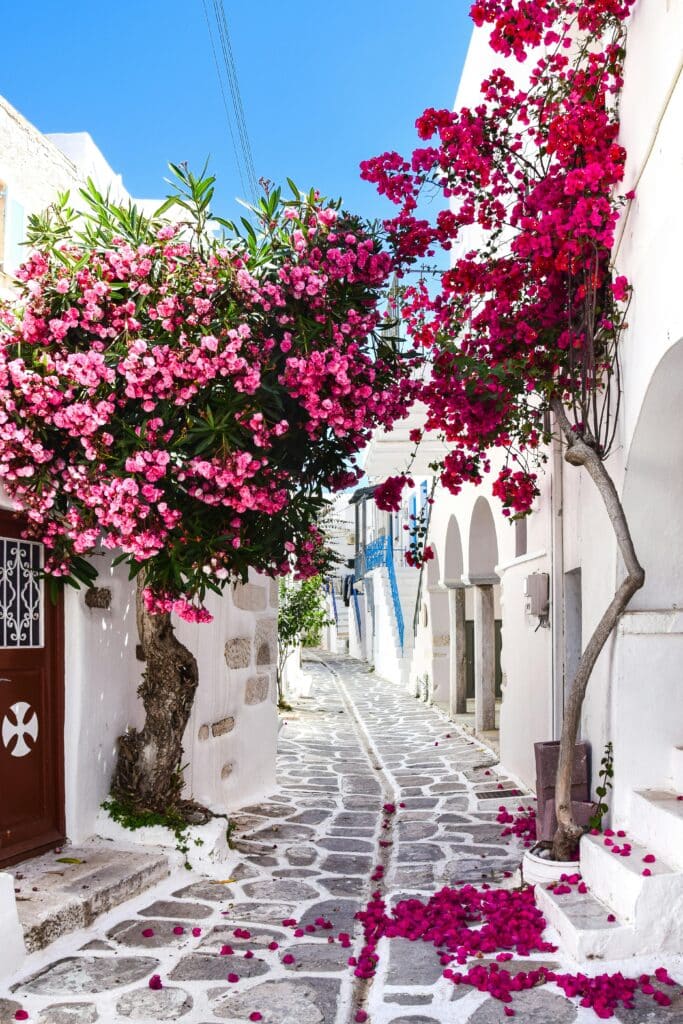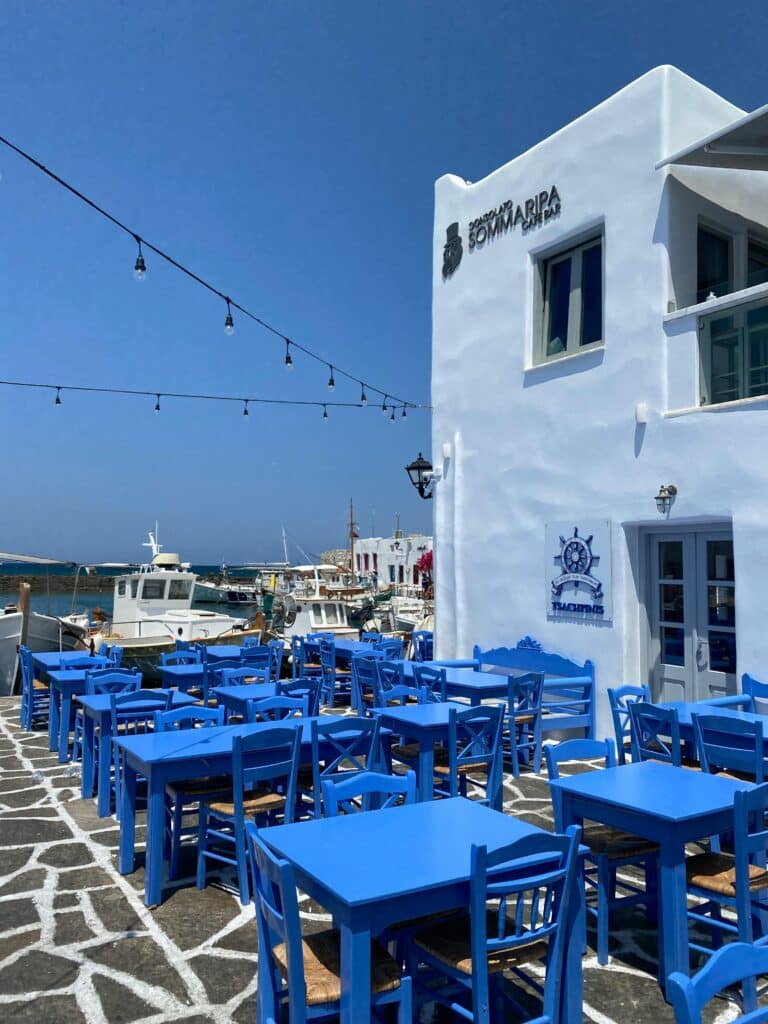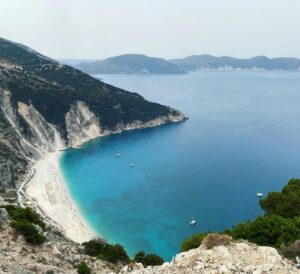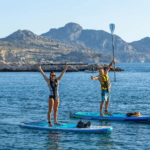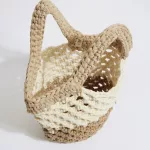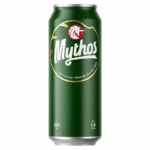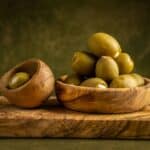Visit Paros: beaches, villages, history and tips for discovering the Cycladic island
Discover Paros differently
Paros is more than just a seaside destination. The island reveals a unique personality to those who take the time to linger. Its identity is revealed in its villages, its heritage, its living traditions and its Mediterranean art of living.
An island between land and sea
Paros offers a rare natural diversity. Mountains, fertile valleys, secret coves and picturesque harbours all blend harmoniously. This striking contrast makes it easy to switch from a swim in crystal-clear waters to a walk in the heart of nature.
Vibrant local life
Unlike other very touristy islands, Paros remains inhabited all year round. This local presence gives its villages an authentic soul. Take a stroll through the narrow streets of Parikia or Naoussa, and you’ll come across craftsmen, fishermen and schoolchildren… Everyday Greek life is still unfolding before your very eyes.
A strategic point in the Cyclades
Thanks to its central position in the archipelago, Paros is an ideal base for exploring neighboring islands such as Antiparos, Naxos and Mykonos. Regular ferry connections make it easy to organize day trips.
History of Paros: between ancient grandeur and multiple influences
An island coveted since Antiquity
From Cycladic times onwards, Paros became a major center thanks to its strategic position and natural resources. The island is particularly famous for its white marble, used in famous works such as the Venus de Milo. This exceptional marble attracted not only artists, but also neighboring powers.
With the arrival of the ancient Greeks, Paros developed temples, sanctuaries and flourishing commercial ports. The island asserted itself in the Medieval wars, allying itself for a time with the Persians. These alliances led to tensions with the other Greek cities.
From Roman Empire to Byzantine domination
Under the Roman Empire, Paros retained its economic role, while seeing its culture adapt to the new masters. The Romans developed infrastructure and encouraged craft production.
Later, the Byzantine era brought spiritual renewal. Numerous churches were built, including the famous Panagia Ekatontapiliani. This 4th-century architectural gem became a place of pilgrimage and a symbol of the Orthodox faith.
The Venetian and Ottoman eras
In the 13th century, the Venetians took possession of Paros. They built the Kastro of Parikia from the stones of ancient temples, creating a curious architectural mix.
Later, the Ottomans took over, but the island retained a degree of local autonomy. In spite of heavy taxation and political tensions, the islanders maintain their traditions. Local culture continues to evolve, between Eastern influences and deep Greek roots.
An island involved in the Greek revolution
In the 19th century, Paros actively joined the struggle for Greek independence. Many of its inhabitants took part in the uprisings against the Ottoman Empire.
After the creation of the modern Greek state, the island regained political stability. Its heritage, natural beauty and geographical position made it a coveted destination, first for intellectuals, then for travellers from all over the world.
Emblematic villages to explore
Parikia, a blend of history and local life
Parikia, the island’s capital, is immediately captivating with its vibrant atmosphere. As you stroll along, the white streets gradually reveal ancient churches, craft stores and typical tavernas. At the heart of the town, the Kastro, a Venetian fortification, dominates the old town, offering a superb panorama of the sea. So a visit to Parikia is like plunging into a rich past while enjoying the island life of today.
Naoussa, with its Cycladic charm and lively atmosphere
A former fishing port turned chic village, Naoussa attracts visitors with its picture-postcard setting. The small port is home to colorful boats, lined with restaurants and terrace cafés. In the evening, the atmosphere becomes festive but remains elegant. It’s the ideal place to enjoy fresh fish, admire the sunset or stroll between art galleries and flower-filled alleyways.
Lefkès, a hidden gem in the heart of the island
Lefkès, the former capital, is perched on a hill. The village, with its whitewashed houses and cobbled streets, is very peaceful. The large Agia Triada church dominates the center. Surrounded by olive groves, Lefkès is also the starting point for the Byzantine Trail, perfect for a stroll to Prodromos. This authentic village offers a soothing break in a lush natural setting.
What are the most beautiful villages on Paros to visit?
Parikia, Naoussa and Lefkès are among the most popular villages. Each offers a unique setting and distinct atmosphere.
Is it easy to get to the inland villages of Paros?
Yes, regular buses and well-maintained roads connect the villages. Renting a car makes it easier to get around.
Beaches: relaxation and idyllic island landscapes
Kolymbithres, an almost lunar setting
Situated in the Bay of Naoussa, Kolymbithres offers a surprising array of wind-sculpted rocks. These granite formations create natural coves, ideal for bathing or relaxing. Thanks to its shallow waters, the beach is perfect for families.
Santa Maria, a lively, sporty beach
Further north, Santa Maria is ideal for water sports enthusiasts. Windsurfing, diving and paddle boarding are all available. Beach clubs also offer sunbeds, music and food. Despite the lively atmosphere, the landscape remains unspoilt.
Faragas, a haven of peace in the south
Less frequented, Faragas nestles in a wind-protected cove. The water is clear and calm. Wooden umbrellas, a secluded tavern and a peaceful ambience make this a great place to relax.
Golden Beach, a surfer's paradise
It’s the longest beach on the island. Golden Beach attracts sports enthusiasts for its constant winds and golden sand. Every summer, international windsurfing competitions are held here. It’s also great for swimming and walking.
Where to find the best beaches on Paros?
Kolymbithres, Santa Maria, Golden Beach and Faragas are among the most famous beaches. They combine beauty and accessibility.
Paros gastronomy: local specialities and good addresses
Paros also appeals for its culinary traditions, inherited from a simple and generous art of living. Indeed, local cuisine reflects the richness of the land, the freshness of the produce and the constant influence of the sea.
A cuisine of land and sea
The island offers a wide range of dishes combining sun-drenched vegetables, local meats and freshly caught fish. Sun-dried tomatoes, stuffed zucchinis, salads with mizithra (a local fresh cheese) and goat’s cheese stew are just some of the dishes on offer. On the seafood side, sun-dried octopus and grilled squid are a must.
Typical products to discover
Paros cheese, particularly xinotyro (sour cheese) and ladotyri (olive oil cheese), are well worth trying. On the sweet side, amygdalota, small almond cakes scented with orange blossom, are emblematic of the Cyclades. Local wine, often produced on small family farms, is the perfect accompaniment to any meal.
Where to eat in Paros?
For authentic cuisine, head for the tavernas of Lefkès or Prodromos. Some seaside addresses in Naoussa or Piso Livadi also offer refined seafood cuisine. For a more family-friendly atmosphere, Parikia’s tavernas offer simple dishes, often prepared using recipes handed down from generation to generation.
Local crafts and traditions: the living soul of Paros
Even today, Paros preserves an ancestral know-how handed down from generation to generation. Throughout the island, craftsmen and designers perpetuate local techniques, some of which are centuries old.
In villages such as Lefkès and Marpissa, numerous workshops open their doors to curious visitors. Here you can watch potters working the clay with precision, shaping vases and plates with typical motifs. Paros ceramics are renowned for their finesse, harmonious shapes and natural hues.
And weaving is still very much alive. Many women still produce fabrics by hand, using traditional looms. Their creations, often colored with natural pigments, are used to make tablecloths, scarves and curtains.
Strolling through the narrow streets of Parikia or Naoussa, you’ll also come across jewellers’ workshops. These craftsmen use local stones and techniques inspired by Antiquity to create unique pieces, often handed down from generation to generation.
At the same time, religious and cultural festivals punctuate island life throughout the year. Every summer, the “panigiria”, traditional village festivals, bring locals and visitors together to enjoy music, dance and cuisine. These eagerly awaited events reflect the island’s spirit of hospitality and sharing.
Paros, through its crafts and traditions, offers an authentic immersion in a warm, unspoilt way of life.
Activities in Paros: relaxation, adventure and discovery
Hiking in the heart of the island
Paros lends itself to nature walks. The famous Byzantine path links Lefkès to Prodromos through olive groves and low stone walls. This historic path, perfectly preserved, reveals splendid panoramas and authentic rural Greece.
Other itineraries lead to perched chapels, such as Agios Antonios, offering exceptional views over the island.
Water sports for all tastes
With its windy beaches, Paros is a well-known spot for kitesurfing and windsurfing, especially near Pounda and Golden Beach. Numerous schools offer courses for beginners and advanced windsurfers.
Scuba diving, paddleboarding and kayaking are also great ways to discover the coastline.
Yoga and well-being in soothing surroundings
Several yoga centers welcome visitors for outdoor sessions. The natural setting encourages calm and reconnection. Some hotels also offer wellness retreats.
Cruises and maritime escapades around Paros
Paros is also an ideal starting point for exploring neighboring islands. Boat excursions take you to Antiparos, a small, peaceful island with wild beaches and impressive caves.
Other cruises take you around Paros, stopping to swim in secret coves accessible only by sea.
Some tours include the discovery of the smaller Cyclades, such as Koufonisia or Iraklia, offering an unforgettable maritime adventure.
These getaways are the perfect opportunity to enjoy the Aegean Sea, dive into translucent waters and discover unspoilt spots far from the crowds.
What cruise to take in Paros to discover the most beautiful landscapes?
To explore the coastal wonders of Paros, opt for a cruise to Antiparos and Despotiko. These trips allow you to discover turquoise lagoons, sea caves and secret beaches. In a small group, you’ll avoid the crowds and enjoy swimming in unspoilt spots. Set off early in the morning or at the end of the day to take advantage of the soft light and calm sea, ideal for photos.
Local festivals and traditions: experience the island differently
In addition to its enchanting landscapes, Paros is also known for its lively traditions and popular festivals. Throughout the year, the island offers unique events, combining spirituality, gastronomy and local music. Every season is an opportunity to discover the authenticity of Parian culture.
Festivities rooted in Cycladic culture
One of Parikia’s most emblematic celebrations is the Assumption on August 15. Religious processions, concerts and fireworks enliven the town around the Ekatontapyliani church. It’s an opportunity to share a special moment with the locals.
In Naoussa, the Pirate Festival, held every August 23, recalls the days of privateer invasions. Disguised locals re-enact a naval battle in the middle of the night. The atmosphere is festive, and the streets are lit up with music and dance.
Gourmet and musical celebrations
During the summer, several villages organize wine and local produce festivals. In Lefkes or Marpissa, you can taste goat’s cheese, homemade wine or stewed dishes, while listening to rebetiko or traditional tunes.
Finally, there are numerous concerts, exhibitions and theatrical performances, especially in July and August. The island comes alive in a convivial atmosphere, conducive to cultural exchange.
What traditional festival is a must on Paros?
The Naoussa Fish Festival, held in August, is one of the most popular events on Paros. It celebrates the island’s maritime tradition with concerts, dances and grilled fish offered to visitors. This festive event is an opportunity to discover the local culture in a friendly atmosphere by the sea. Be sure to arrive early to make the most of the evening and avoid the crowds.
Practical information for organizing your stay in Paros
Getting to Paros is easy
Getting around the island
Once you’ve arrived, there are several options open to you. Renting a car or scooter is the most flexible way to explore the island. Agencies are available near the port and airport.
The bus network is well organized, especially in high season. It links the main villages and beaches at low cost. To discover isolated coves, opt for water cabs or maritime shuttles.
How many days in Paros?
Best time to visit
Useful tips for worry-free travel



